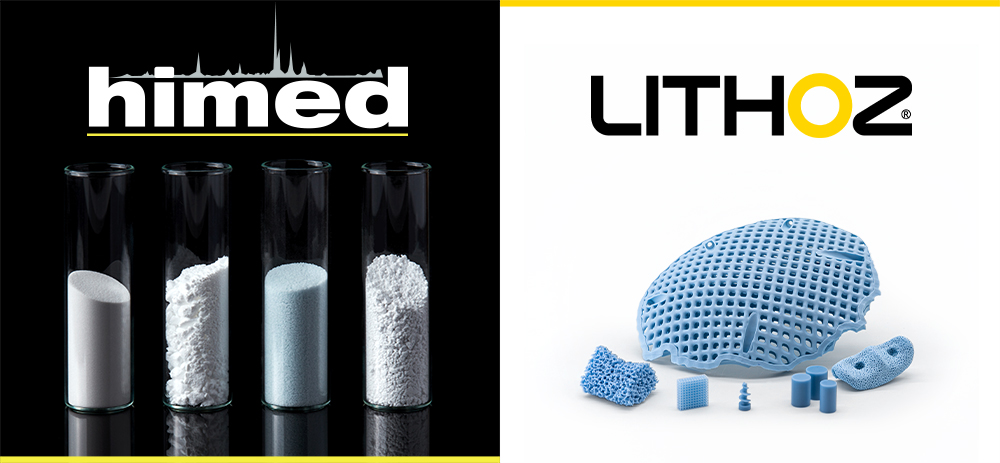• Lithoz GmbH, world leader in ceramic 3D printing, and New York-based biomaterials manufacturer Himed sign strategic research partnership agreement to further accelerate the development of medical-grade bioceramics
• Focusing on implants using biocompatible calcium phosphates, the cooperation will better meet the strongly increasing demand for innovative 3D-printable bioceramic feedstocks
• Himed acquires a Lithoz CeraFab S65 Medical Printer to explore novel integrations of their leading calcium phosphate biomaterials with Lithoz’s proprietary ceramic binder
Lithoz GmbH, global market and innovation leader in ceramic 3D printing, and New York-based biomaterials specialist Himed have entered into a long-term partnership, joining forces in further driving innovation and research into the 3D printing of medicalgrade bioceramics.
This joint effort, including Himed’s acquisition of a CeraFab S65 Medical printer, follows last year’s successful Formnext, where Lithoz received tremendous feedback on the launch of its significantly improved LithaBone HA 480 material. After searching for a strategic partner in the United States to better access the enormous potential of top-level surgery specialists there, this partnership forms the next logical step in the large-scale commercialization of this highly specific 3D printing product, but also will form a powerful intercontinental pool of top researchers driving 3D-printable bioceramics to the next level. Partnering with Himed allows Lithoz to explore the potentials of other CaP phases within the highly sophisticated biomimetic forms their printers can make.
Thanks to their fascinating properties, such as excellent biocompatibility and osteoconductivity, the tricalcium phosphate or hydroxy apatite based LithaBone medical ceramics have proven to be a highly attractive alternative to metals used in human surgery. Lithoz has also received numerous innovation study requests involving these bioceramics, as the precision and design flexibility of Lithoz LCM technology possess huge potential for innovation when it comes to lattice structures and porostities achieving the desired ideal level of osteoconductivity.
First-phase research will occur at Lithoz’s U.S. location in Troy, NY this summer by a joint team of materials scientists. Himed will install a new Lithoz CeraFab S65 printer at their 25,000 sq. ft. facility in Long Island early this fall, allowing the company to more rapidly experiment on site and run important analytical testing at its in-house laboratory. The addition of a CeraFab S65 at Himed also broadens their R&D service offerings, adding rapid prototyping of different forms for clients who contract with Himed to conduct unique biomaterials research.
Himed’s CEO, Dana Barnard, explains, “Himed understands CaP optimization and how to scale it for a growing market. We’ve refined many calcium phosphates to strengthen their healing potential, but most of these were targeted toward surface coatings on traditionally manufactured titanium implants. Lithoz’s remarkable 3D printing technology allows a whole new direction for our products, in which we can use CaP to its greatest advantage—as a biomimetic material within the implant structure itself that can be replaced by a person’s own natural bone over time.”
Lithoz CEO Dr. Johannes Homa takes the same line: “This is definitely a big milestone for our partnership, and just a first starting point for a mutual beneficial collaboration for additive manufacturing of bone replacement.”
Ultimately, both companies believe there is still much to discover about developing CaP materials to augment the performance of 3D-printed implantable forms. This strategic partnership represents a first step in growing the range of biocompatible materials suitable for a future that includes highly customized, patient-specific medical solutions that can be printed on demand. Over the last thirty years, calcium phosphates such as hydroxy apatite have gained widespread use in implantable devices, bone putties, and grafting materials for their similarity to natural bone, and can aid the organic regrowth of hard tissue at the implantation site. Since 1991, Himed has collaborated with different medical implant manufacturers to develop and optimize various CaP powders and surface treatments for osseointegration. The partnership with Lithoz, however, allows new opportunities for Himed in the medical additive manufacturing market beyond bioactive surface treatments and postprocessing of implants.






